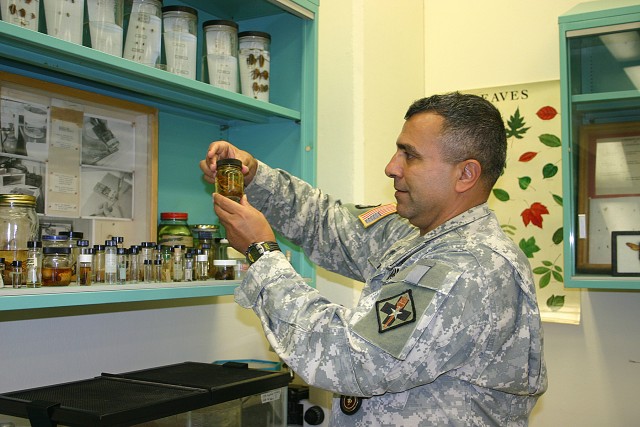
FORT SAM HOUSTON, Texas -- The chief of the Medical Zoology Branch at the Army Medical Department Center and School, Fort Sam Houston makes it his mission to teach Soldiers about bugs, the diseases they carry and ways to protect themselves downrange.
During the five-week Medical Zoology course, Col. (Dr.) Mustapha Debboun teaches Soldiers how to identify arthropods such as insects and spiders, as well as snakes and rodents.
Soldiers learn methods of surveying areas for infestation and how to control and manage insects or rodents using personal protective equipment or pesticides. They are also taught signs and symptoms of diseases that can threaten our war fighters.
Debboun realized the same information he teaches Soldiers as part of the Preventative Health Specialty Course could also be useful to the public. Debboun and two colleagues, retired Col. (Dr.) Daniel Strickman and Dr. Stephen Frances, collaborated to write a book titled, "Prevention of Bug Bites, Stings and Disease."
Using a combination of line drawings and photographs the book helps people identify bugs ranging from scorpions, spiders, ants, mosquitoes, bees, ticks, lice, and flies. It includes helpful tips on personal protection and how to apply pesticides safely.
Common insect threats in San Antonio include mosquitoes carrying heart worm disease that may affect our pets Debboun said.
"Lyme disease from ticks can also be a problem because of the large deer population," he explained. "Flies can also spread disease."
If bitten by a snake the best thing to do is, "keep the person calm, have them lie down and put a cold compress on the bite. If possible, without endangering yourself, get the snake or the head of the snake and bring it with you to the clinic," Debboun said. "This will help (the medical provider) determine what anti-venom to use."
Debboun said it took about a year and a half to compile information for this recent book.
"My specialty is arthropod repellents. I have tested repellents used in the military. This book has important information for everybody, not just in the United States, but if you are traveling to other countries as well."
Debboun served in the U.S. Army for 20 years and has been an instructor at AMEDDC&S for four years. He also co-authored a previous book, "Insect Repellents: Principles, Methods, and Uses."

Social Sharing